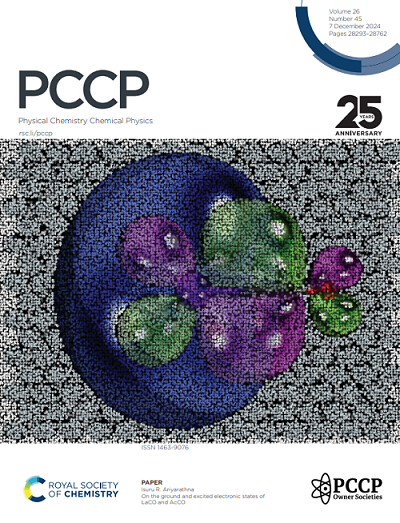Solid state NMR and DFT studies of azo-hydrazone tautomerism in azo dyes and chitosan-dye films
IF 2.9
3区 化学
Q3 CHEMISTRY, PHYSICAL
引用次数: 0
Abstract
The properties of materials containing azobenzene depend strongly on the dynamics of cis and trans isomerization which in turn is influenced by the presence of the different possible tautomers. Two commonly used food azo dyes, Allura Red (ALR) and Amaranth (AMA) were studied by NMR spectroscopy to experimentally determine their tautomeric forms and then theoretically rationalized. Variable temperature 2D 1H-15N HMBC NMR provided a direct measure of the hydrazone percentage of the dyes in solution which was complimented by 1H ultrafast magic-angle spinning (MAS) and 13C CPMAS solid state NMR to characterize the structures of the solid dyes alone and incorporated into chitosan films designed to disassemble upon exposure to light and water. Density functional theory (DFT) calculations were carried out to predict tautomeric equilibria in comparison to NMR measurements and rationalize the observed equilibrium in terms of electronic structure effects computed in the Natural Bond Orbital analysis framework. In agreement with NMR results, the hydrazone form was strongly favored in a polar solvent, driven primarily by stabilizing resonance delocalization and favourable electrostatic interactions with solvent. Our observations show that the ALR and AMA dyes exist predominantly in the hydrazone form of their tautomeric equilibrium in solution, in the solid-state, and in a chitosan-dye film. These results indicate that since disassembly of the chitosan-dye films, potential substitutes for petrol-based polymer films, is based on cis-trans isomerization of the azo form, other water soluble food dyes with a higher azo contents should be explored.含有偶氮苯的材料的特性在很大程度上取决于顺式和反式异构化的动态,而顺式和反式异构化又受到不同同分异构体的影响。我们利用核磁共振光谱研究了两种常用的食品偶氮染料:Allura Red (ALR) 和 Amaranth (AMA),通过实验确定了它们的同分异构体形式,然后从理论上对其进行了合理化分析。变温二维 1H-15N HMBC NMR 直接测量了溶液中染料的腙百分比,并辅以 1H 超快魔角旋光 (MAS) 和 13C CPMAS 固态 NMR 分析了固体染料的单独结构和与壳聚糖薄膜的结合结构,这些薄膜在暴露于光和水后会分解。通过密度泛函理论(DFT)计算来预测同分异构平衡,与核磁共振测量结果进行比较,并根据天然键轨道分析框架中计算的电子结构效应使观察到的平衡合理化。与核磁共振结果一致的是,在极性溶剂中,腙形式更受青睐,这主要是由稳定共振脱位和与溶剂的有利静电作用驱动的。我们的观察结果表明,ALR 和 AMA 染料在溶液、固态和壳聚糖-染料薄膜中主要以其同分异构体平衡的腙形式存在。这些结果表明,由于壳聚糖-染料薄膜--汽油基聚合物薄膜的潜在替代品--的分解是基于偶氮形式的顺反异构,因此应探索偶氮含量更高的其他水溶性食品染料。
本文章由计算机程序翻译,如有差异,请以英文原文为准。
求助全文
约1分钟内获得全文
求助全文
来源期刊

Physical Chemistry Chemical Physics
化学-物理:原子、分子和化学物理
CiteScore
5.50
自引率
9.10%
发文量
2675
审稿时长
2.0 months
期刊介绍:
Physical Chemistry Chemical Physics (PCCP) is an international journal co-owned by 19 physical chemistry and physics societies from around the world. This journal publishes original, cutting-edge research in physical chemistry, chemical physics and biophysical chemistry. To be suitable for publication in PCCP, articles must include significant innovation and/or insight into physical chemistry; this is the most important criterion that reviewers and Editors will judge against when evaluating submissions.
The journal has a broad scope and welcomes contributions spanning experiment, theory, computation and data science. Topical coverage includes spectroscopy, dynamics, kinetics, statistical mechanics, thermodynamics, electrochemistry, catalysis, surface science, quantum mechanics, quantum computing and machine learning. Interdisciplinary research areas such as polymers and soft matter, materials, nanoscience, energy, surfaces/interfaces, and biophysical chemistry are welcomed if they demonstrate significant innovation and/or insight into physical chemistry. Joined experimental/theoretical studies are particularly appreciated when complementary and based on up-to-date approaches.
 求助内容:
求助内容: 应助结果提醒方式:
应助结果提醒方式:


